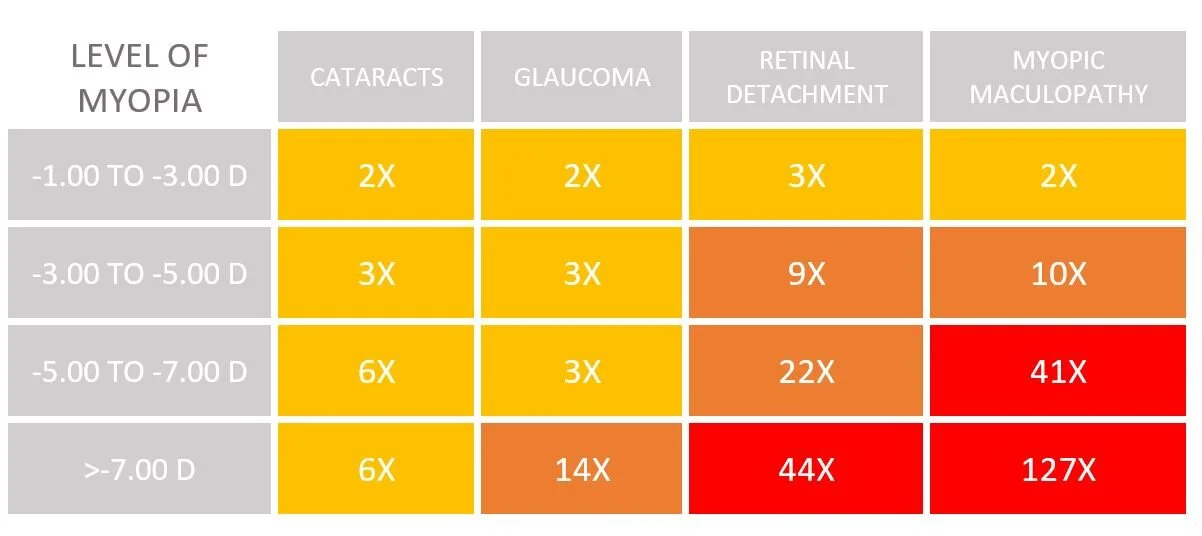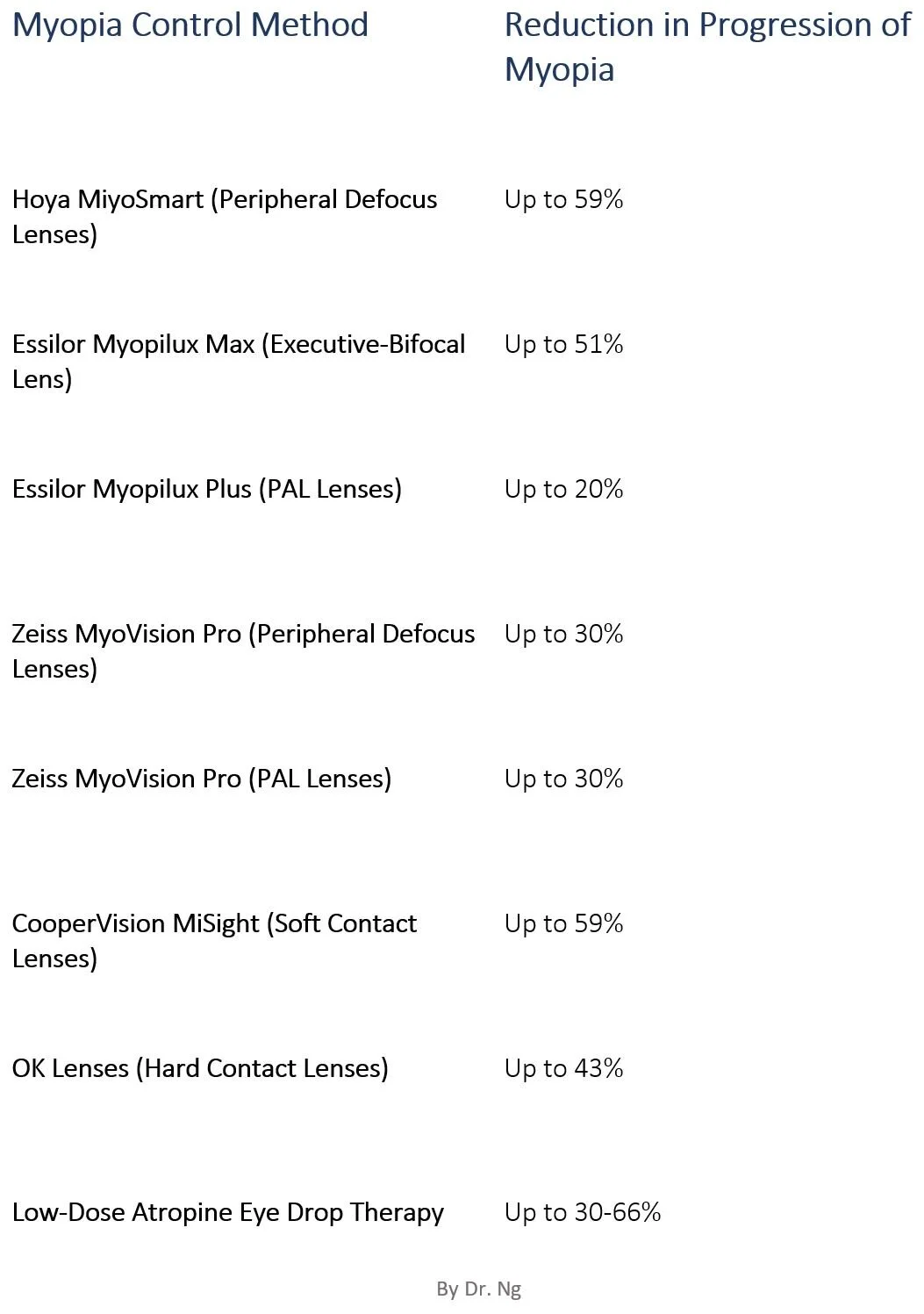Pandemic and Myopia Progression, Myopia Causes and Control Options
Michael Ng
The Problem
COVID-19 has made learning from home the new norm. With schools moving to online learning, that also means children are spending upwards of 8 hours every day in front of a computer screen in a fixed position. In addition, adults working from home for all types of jobs have increased the need to work longer hours in front of screens. I have observed an increase of myopia of upwards of 100% increases (doubling) in my practice for young adults and children.
Myopia Prediction: Now and 2050
Myopia (near-sightedness) is a common eye condition where an individual cannot see far but can see near. Light bends and focuses in front of the retina instead of on the retina, resulting in a blurry image.
WHY?
Myopia increases risk for severe eye diseases
Adapted from Flitcroft DI. The complex interactions of retinal, optical and environmental factors in myopia aetiology. Prog Retin Eye Res. 2012.
You can see from the chart above that having mild myopia (-1.00 to -3.00) can more than double your chances for severe eye diseases. Moderate myopia (-3.00 to -6.00) can 3-9x increase your chances for severe eye diseases. High myopia (over -6.00) can severely increase your chance of severe eye diseases which can cause long-term damage to your vision. Preventing your eyes from increase can have life-changing vision results.
Myopia Risks for Progression
There are several factors that can cause myopia progression including:
Genetics (family history, ethnicity),
Individual Characteristics (age, eye profile, and health),
Eye Efficiency (eye alignment, eye muscles, and eye teaming), and
Environmental Factors
We will briefly explore the different factors below.
Genetics
Studies have shown if one parent is myopic, it increases the risk of their children being myopic by 3x, and if both parents are myopic, it increases the risk by 6x and increases the chance of greater progression to high myopia. In addition, the risk for myopia is also higher for first-born child than for the second.
1 Myopic Parent ➤ 3x Risk
2 Myopic Parents ➤ 6x Risk + greater progression to HIGH MYOPIA
ETHNICITY
East /South-East Asian ethnicity has a greater chance of developing myopia, which shows in their prevalence up to 69% by age 15. Particularly Singaporean-Chinese up to 86%. Black Africans had the lowest prevalence of 5.5% by age 15. In general, children of mixed, Hispanic, Asian, and white ethnicity progressed more than African American children.
Eye Profile
Onset of myopia before 6 years old with less than +0.50 D, and a progression of -0.75 or more in a year is a risk factor. A 0.5mm increase in axial length correlated with 1D of increase of myopia.
Myopia before 6 years old ➤ 6.6X RISK
Eye Efficiency
How the eyes work together and positioning of eye muscles can also predict myopia progression. Studies have shown an increased accommodative lag and esophoria / convergence excess may predict myopia progression.
ENVIRONMENT
Our environment and lifestyle can influence myopia progression as well. Studies have shown that constant near work (3+ hours a day) along with decrease outdoor activity has caused an increase in myopia progression. With lockdowns in place along with online-learning, children are spending more time in front of screens with less time playing outdoors. The risk also increases for families living in urban cities than in rural, up to 2.6x more progression.
Spending less than 1.6 hours a day outdoors ➤ 2-3X RISK
Living in urban vs rural ➤ 2.6x risk
The Solution
Now you know your risk factors and causes of myopia progression. We can start by changing your lifestyle and environment for prevention. Speak to your Optometrist to find out how to slow down myopia.
We know that spending 90 mins of outdoor activity daily is essential for eye and health development. You can break these into two (45 min) or three (30 min) sessions throughout the day.
Take a break every 20 mins of screen time for at least 10 minutes.
Children should study in well light rooms that are larger with natural lighting.
Computer screens should match the brightness of the room and not contrast it. I.e. do not work in a dark room with a bright screen.
Eat healthy diet rich in high antioxidants including lutein and zeaxanthin and omega-3: dark greens (spinach, kale), fruits (blueberries), and omega 3 (eggs and fish).
Consider Myopia Control Therapy
Optometrists now have various tools to control myopia. The risk of high myopia not only changes your child’s life choices but also increases their chance for severe eye diseases later in life that could visually affect their quality of life. Glasses is not the only option now for correction. We can now correct and prevent further progression. Here are some of the options your optometrist may explore with you:
Soft Contact Lenses for Kids ➤ up to 59% reduction
Myopia Control Eye Drops ➤ up to 30-66% reduction dosage dependent
Myopia Control Glasses ➤ up to 20-59% reduction, dependent on lens type
OK Lenses ➤ up to 43% reduction
Combination Treatment
Studies








